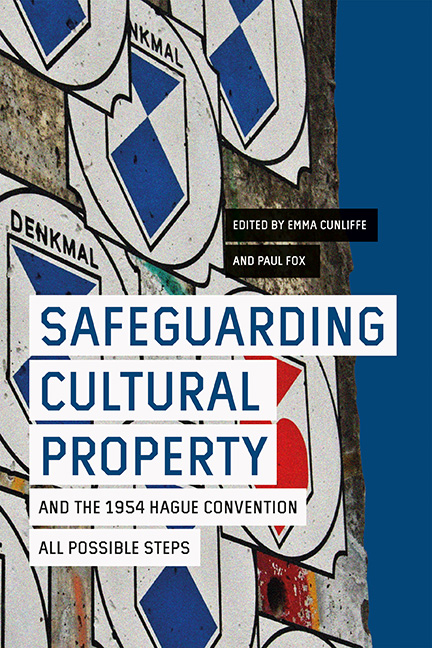Book contents
- Frontmatter
- Contents
- List of Illustrations
- List of Contributors
- Plate Section
- Acknowledgements
- List of Abbreviations
- Preface: The Blue Shield and the Protection of the World's Cultural Property – Preparing in Peace for Conflict
- Part I Safeguarding – Reassessing the Field
- Part II Historical Perspectives
- Part III Current Issues in Legal Implementation
- Part IV The Hague Convention in Practice Today: Tools and Approaches
- Appendix 1 The Hague Convention for the Protection of Cultural Property in the Event of Armed Conflict with Regulations for the Execution of the Convention 1954
- Appendix 2 Regulations for the Execution of the Convention for the Protection of Cultural Property in the Event of Armed Conflict
- Appendix 3 Resolutions of the 1954 Hague Conference
- Appendix 4 Second Protocol to the Hague Convention of 1954 for the Protection of Cultural Property in the Event of Armed Conflict 1999
- Appendix 5 Additional Protocols (1977) to the Geneva Conventions (1949) (Extracts)
- Index
- HERITAGE MATTERS
11 - Safeguarding and the 1954 Hague Convention for the Protection of Cultural Property: The Syrian Example
Published online by Cambridge University Press: 26 May 2022
- Frontmatter
- Contents
- List of Illustrations
- List of Contributors
- Plate Section
- Acknowledgements
- List of Abbreviations
- Preface: The Blue Shield and the Protection of the World's Cultural Property – Preparing in Peace for Conflict
- Part I Safeguarding – Reassessing the Field
- Part II Historical Perspectives
- Part III Current Issues in Legal Implementation
- Part IV The Hague Convention in Practice Today: Tools and Approaches
- Appendix 1 The Hague Convention for the Protection of Cultural Property in the Event of Armed Conflict with Regulations for the Execution of the Convention 1954
- Appendix 2 Regulations for the Execution of the Convention for the Protection of Cultural Property in the Event of Armed Conflict
- Appendix 3 Resolutions of the 1954 Hague Conference
- Appendix 4 Second Protocol to the Hague Convention of 1954 for the Protection of Cultural Property in the Event of Armed Conflict 1999
- Appendix 5 Additional Protocols (1977) to the Geneva Conventions (1949) (Extracts)
- Index
- HERITAGE MATTERS
Summary
The 1954 Hague Convention for the Protection of Cultural Property in the Event of Armed Conflict (‘the Convention’) lays out a system for the ‘safeguarding of cultural property’ to be planned and managed ‘in time of peace … against the foreseeable effects of an armed conflict’ (Article 3), which is then implemented should conflict occur. Civil unrest started in Syria in 2011; in 2012 it became a non-international armed conflict (NIAC) and international humanitarian law (IHL) applied. We examine Syria's cultural property protection (CPP) preparations, and how those measures manifested once conflict occurred. Syria is party to the Convention and its 1954 First Protocol, but not to the 1999 Second Protocol (which it has signed but not ratified).
In signing the Convention, High Contracting Parties (HCPs) confirm that they are ‘of the opinion that protection cannot be effective unless both national and international measures have been taken to organize it in time of peace’, meaning they should be completed in advance, irrespective of the eventual type of conflict.
The safeguarding measures in the Convention (elaborated in the Regulations for the Execution of the Convention – ‘Regulations’) require the designation of competent authorities to administer the Convention (Article 15), the completion of ‘appropriate’ safeguarding measures (Article 3), and the dissemination of the Convention ‘to the whole population’ (Article 25). Article 3 does not contain specific measures (these were removed during drafting (O’Keefe 2006)), but the Second Protocol contains (non-obligatory) exemplars (Chamberlain 2013), which form good practice. These are:
the preparation of inventories, the planning of emergency measures for protection against fire or structural collapse, the preparation for the removal of movable cultural property or the provision for adequate in situ protection of such property, and the designation of competent authorities responsible for the safeguarding of cultural property (Article 5).
In addition, the placement of the distinctive emblem (Chapter V), the creation (and ideally practising) of procedures to evacuate movable CP to refuges (Chapter III), and the identification and registration of sites for special protection (Chapter II) should also all clearly be considered safeguarding measures – prepared by the civil authorities to underpin the military measures.
- Type
- Chapter
- Information
- Safeguarding Cultural Property and the 1954 Hague ConventionAll Possible Steps, pp. 181 - 204Publisher: Boydell & BrewerPrint publication year: 2022



